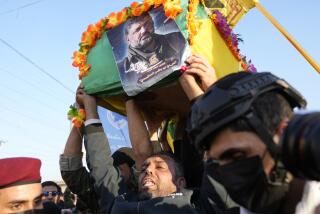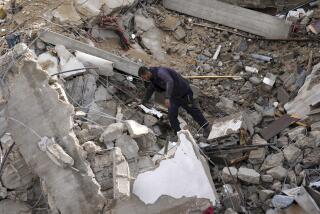Key Battle Begins Near Baghdad
- Share via
WITH U.S. FORCES IN IRAQ — U.S. Army troops confronted thousands of Republican Guard soldiers Monday across the strategic Karbala Gap, just 60 miles south of Baghdad, in what American and British officials called one of the most crucial -- and perilous -- encounters so far in the war.
U.S. B-52 bombers and Apache helicopters attacked Republican Guard positions to the north of the gap to weaken them before the battle for Baghdad, while the 2nd Brigade of the Army’s 3rd Infantry Division spread across high desert to the south and west of the gap, facing three brigades of the guard’s prized Medina Division on the other side.
The fighting at the mountain pass came as thousands of troops, tanks and guns stretching for 30 miles rolled northward toward Baghdad in the campaign to drive Saddam Hussein from power. The Iraqi president appeared to be in control of the government Monday, with an appearance on television, touted as live, in which he vowed that “victory will soon be ours.”
The Iraqis sent an armored column south toward the gap near Karbala, a Shiite Muslim holy city and strangle point for troops advancing on Baghdad. Allied planes destroyed 10 of the tanks and several other armored vehicles. U.S. commanders said the air support pushed the Iraqi column back.
A U.S. helicopter was forced down during heavy fighting near Karbala, the U.S. Central Command said in Doha, Qatar, and its two-man crew was missing. Iraqi TV showed the two men, and the Pentagon listed them as prisoners of war -- the sixth and seventh Americans to be captured by the Iraqis.
In London, Prime Minister Tony Blair said the battle of Karbala Gap against defenders of the route to Baghdad was a “crucial moment.” At the Pentagon, Maj. Gen. Stanley A. McChrystal, vice director for operations at the Joint Chiefs of Staff, said fighting the Republican Guard propels the war into a far more dangerous phase.
The Medina Division invaded Kuwait for Hussein in 1990 and engaged U.S. troops in one of the largest and most furious tank battles of the 1991 Persian Gulf War. U.S. commanders who confronted Medina’s heavy armor would come to call that encounter the Battle of Medina Ridge.
In Hussein’s latest television appearance, his references to the shape of the war so far suggested that the remarks were current. But in London, British Defense Minister Geoff Hoon insisted that the broadcast wasn’t live, adding Britain had learned that Hussein had taped several messages and might air more in the future.
In Baghdad, Iraqi Information Minister Mohammed Said Sahaf said 62 civilians had been killed across Iraq in 24 hours by U.S. and British troops, missiles and bombs. He said hundreds more had been injured. In an indication that battle was drawing near, huge bomb explosions erupted in the eastern and southern suburbs.
From Baghdad south, where two days of sandstorms were forecast, U.S. and British forces faced assaults from paramilitary forces loyal to Hussein. A sniper killed a U.S. soldier near the town of Najaf, and a British Royal Marine died as he tried to calm a riot farther to the south near Basra, Iraq’s second-largest city.
Resistance persisted at Nasiriyah, as Iraqis fired at U.S. troops with machine guns. Some of the Iraqis wore military uniforms, but others were in civilian clothes. One oil well burned. U.S. forces dropped bombs and fired mortars into the town throughout Monday night, killing several Iraqis. About two dozen surrendered.
Seven of the Marines killed in fierce fighting Sunday at Nasiriyah were identified Monday by the Pentagon. They included three Californians: Sgt. Michael E. Bitz, 31, of Ventura; Cpl. Jose A. Garibay, 21, of Orange; and Cpl. Jorge A. Gonzalez, 20, of Los Angeles.
Four Iraqi missiles were fired Monday at Kuwait, bringing to 10 the total since the war started Thursday. Two of the missiles, fired in the night, glowed orange in the sky, and one at midday boomed over Kuwait City. All four were destroyed by U.S. Patriot missiles.
To the west, bombs from a U.S. jet hit a bus carrying civilian workers to neighboring Syria, killing five and injuring 10. McChrystal said the pilot was aiming at the bridge. “[The] bus came into the pilot’s view,” he said, “but [it was] too late to recall the weapons.”
Crewmen on Iraqi TV
The helicopter downed near Karbala was an AH-64 Apache gunship returning from a mission to attack the Republican Guard. Iraq’s television footage of the men showed two people in beige flight suits. Neither spoke, and both appeared frightened.
Reporters with U.S.-led troops said at least 30 other helicopters in the operation were hit by small-arms fire.
Iraqi officials claimed that the Apache was shot down by farmers, and Iraqi television showed a group of dancing men celebrating by waving carbines and Kalashnikov assault rifles.
U.S. officials, however, said the farmers had not shot the helicopter, which appeared to be undamaged, as if it had set down, perhaps after experiencing mechanical failure.
Two helmets could be seen lying near the aircraft.
Later, American jets reportedly destroyed the helicopter in an airstrike so the Iraqis could not gain information from it.
At the Pentagon, McChrystal said he hoped the Iraqis would not mistreat the crew.
He said coalition forces were treating Iraqi prisoners “with dignity and respect,” in accordance with the Geneva Convention on the conduct of war. More than 50 Iraqis, including soldiers and civilians, have been taken to U.S. Navy ships for medical care, Pentagon spokeswoman Victoria Clarke told reporters.
She and McChrystal condemned as “despicable” the Iraqi ruses that cost the lives of several of the 17 Americans who were killed Sunday.
The Iraqis “are sending forces out carrying white surrender flags or dressing them as liberated civilians to draw coalition forces into ambushes,” Clarke said.
“Both of these actions are among the most serious violations of the laws of war. Known as perfidy or treachery, such acts are strictly prohibited,” she said.
“They make it extraordinarily difficulty for coalition forces to accept surrendering forces or protect civilians.”
Fight or Be Killed
In addition, McChrystal said, Iraqi civilian volunteers trained in combat, known as the Fedayeen Saddam and headed by Hussein’s son Uday, might be preventing regular soldiers from surrendering.
“We believe from prisoner-of-war debriefings that the Fedayeen may be ... giving the soldiers a choice of either fighting or being shot in the back if they attempt to surrender,” McChrystal said.
The dogged opposition from Hussein loyalists, especially the Fedayeen, dashed initial expectations that the invasion would be smooth and welcomed with adulation.
The U.S.-led forces had planned to push their way straight to Baghdad, bypassing cities and towns on the way.
But they left instability in their wake, along with exposure to guerrilla hit-and-run attacks.
Hussein mentioned one example in his speech, referring to Umm al Qasr, Iraq’s southern port, where resistance continued for days after the United States called it conquered.
Another example was Basra, which the British declared a military objective and where troops traded fire with members of Hussein’s ruling Baath Party. “Elements of the Iraqi army retreated into the city,” British Col. Chris Vernon told reporters in Kuwait City.
“There are irregular forces, Baath Party zealots who are attacking us in civilian clothes,” Vernon said. “These were the people we fought in Umm Qasr. We’re talking about several hundred in Basra.”
Securing the port at Umm al Qasr is crucial to efforts to bring humanitarian aid into Iraq for its civilian population. Basra is important to efforts to move the aid northward.
Paramilitary groups, including the Fedayeen, also are responsible for suppressing unrest among Iraqi civilians, part of Iraq’s efforts to quell any anti-government uprising. Before the war began, there were reports that Hussein might order the use of chemical weapons against his own people.
Secretary of State Colin L. Powell, in an interview Monday with Fox News, confirmed reports of new intelligence that Ali Hassan Majid, one of Hussein’s cousins, had developed such plans.
“We are concerned about it,” Powell said. “We will follow this matter carefully.”
On the battlefield, the two main military groups leading the march on Baghdad crossed the Euphrates River before halting for the aerial assault on the Republican Guard near the Karbala Gap. Members of the 3rd Infantry Division formed a flank to the south and west. The 1st Marine Division formed a flank to the east.
Massive convoys of hundreds of tanks, Humvees, howitzers and armored personnel carriers clogged three lanes of Iraq’s north-south highway through the area. The Marines posted extra security. They stationed themselves on overpasses, and helicopters escorted their convoys from above.
An American pilot returning to the carrier Abraham Lincoln in the Persian Gulf said he could see coalition troops and armor stretching for 30 miles, parked bumper to bumper, waiting for a go-ahead.
In the north, a military Islamic group operating along the mountainous Iranian border, battered in recent days by U.S. cruise missiles, was negotiating with the Kurdish government in the region to surrender.
The group, known as Komaly Islami, has about 1,000 fighters. It is seeking to distance itself from Ansar al Islam, which has 500 to 700 guerrillas and is considered a terrorist organization by the Bush administration.
U.S. airstrikes have destroyed several Komaly strongholds and killed more than 60 of its members. “They are scared,” said a senior Kurdish official, who said he expected a surrender agreement to be reached today. “Cruise missiles ... make you listen.”
Between 200 and 400 U.S. soldiers were preparing to attack Ansar, which is suspected of having links to Al Qaeda.
They were to be joined by 7,000 Kurdish fighters from the Patriotic Union of Kurdistan, which controls the eastern part of an autonomous region in northern Iraq.
A U.S. official said an agreement with Turkey has not been finalized on its plans to send thousands of troops into the Kurdish-controlled region. The Kurds object to any Turkish military presence.
The official said talks would continue today.
*
(BEGIN TEXT OF INFOBOX)
U.S. and British deaths
*--* Killed When Where Circumstances 8 British, 4 Friday Kuwait Helicopter crash American 2 American Friday Southern Iraq In combat 1 American, 6 Saturday Persian Gulf Helicopter collision British 1 American Saturday Kuwait Camp grenade attack 1 American Sunday Kuwait Vehicle accident 9 American Sunday Nasiriyah Fake surrender 2 British Sunday Kuwait Jet down in friendly fire 1 American Monday Najaf Shot by sniper 1 British Monday Basra Killed during riot
*--*
*
(BEGIN TEXT OF INFOBOX)
Military totals
*--* U.S Britain Iraq Killed 19 17 Unknown Missing 7 2 Unknown Captured 7 0 3,000
*--*
*
(BEGIN TEXT OF INFOBOX)
Civilian casualties
Iraq has reported at least 146 civilians killed. One Australian and one British journalist have been killed. Two British journalists are missing.
*
Mohan reported from the 3rd Infantry Division and Wilkinson from Doha. Times staff writers Jeffrey Fleishman in northern Iraq; David Wharton in Kuwait City; Tyler Marshall in Qatar; Rick Loomis in Nasiriyah; Sebastian Rotella in London; Carol J. Williams on the Abraham Lincoln; Paul Richter, Robin Wright and John Hendren in Washington; and special correspondent Amberin Zaman in Ankara, Turkey, contributed to this report.
More to Read
Sign up for Essential California
The most important California stories and recommendations in your inbox every morning.
You may occasionally receive promotional content from the Los Angeles Times.













